Welcome to the Plastic Age…
“We often talk about the Stone Age, the Iron Age, the Bronze Age… Now, people are starting to refer to this age as the Plastics Age – it’s in everything,” MBA’s founder Mike Biddle explains, speaking in Pharrell Williams’ new film-documentary ‘The Plastic Age’. The film, launched to bring greater global awareness to the plastic pollution issue, sees Biddle join a host of speakers including Markus Erikson and Anna Cummins from not-for-profit organisation 5 Gyres, Tyson Toussant of Bionic Yarn, and Captain Charles Moore, the man who discovered the Great Pacific Garbage Patch back in 1997.
Speaking about his discovery, Moore explains that he felt compelled to understand how much plastic was there. His expeditions found six times as much plastic as plankton in 1999, which rocketed up to 36 times by 2009. Now, the Ocean Conservancy estimates that there could soon be as much plastic in the oceans as fish.
The 17-minute film begins by taking viewers through the crazy marketing frenzy that surrounded plastics in the 1950s, as ‘convenience’ became the new buzz word, through to the 288m tonnes of plastic now being produced each year. It highlights that much of this plastic, millions of tonnes, finds its way to the oceans.

“You can dip a net into any ocean in the world and find plastic,” says Cummins. “It gets there through storm drains and rivers… It blows out of garbage cans and falls out of dumpster trucks.”
“In the past 50 years, we have ‘plasticised’ our planet,” adds Erikson.
The story continues in Hawaii, the world’s most isolated archipelago, where people including conservationists and surfers regularly find plastic waste that has washed up from the Great Pacific Garbage Patch – from as far away as Russia, America and Asia. We also hear how commonplace it has become for humans to have synthetic chemicals flowing through their veins, partially as a result of eating fish that have consumed small particles of plastic in the oceans.
It’s not all doom and gloom, however. The film is cautiously optimistic about humans’ ability to turn the situation around. Speakers consistently point out that the plastic waste in the ocean is waiting to be mined, that we can make use of it to meet our existing needs, without making petroleum-based plastic from scratch.
“The volume of plastic produced annually is the same weight as every man, woman and child on Earth,” says Captain Moore. “Imagine if we recovered and reused it.”
“Humans adapt, we’re creative – that’s what we do so well,” adds marine biologist Dr Wallace Nichols.

The new G-Star RAW ‘Raw for the Oceans’ range of denim clothing, co-created by Williams, illustrates a new way of doing business that protect oceans, according to Parley, the group that helped to catalyse the project.
Indeed, harnessing people’s imagination and innovating through unusual multi-stakeholder collaborations is what we need to tackle this monumental issue, the film concludes.
To view the full ‘Plastic Age’ documentary, please click here.

